It’s pretty basic — if you can think upside down.
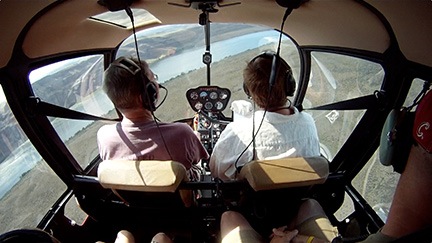
A frame-grab from a “cockpit cam” video. This flight had all seats occupied.
The other day I received yet another request for information about how I mount GoPro cameras on my R44 helicopter. For various reasons, I don’t like to share details about certain mounting techniques. But this one asked about my cockpit mount, which offers a view from the back of the cockpit through the front windows — with limited views out the side windows, too. The pictures throughout this post show some good examples.
This is, by far, my most basic mount. It doesn’t require any special equipment — just one of the flat adhesive mounts that come with a GoPro camera, a white vibration isolator (which I think still comes with a GoPro camera), and the camera’s case.
Stick one of the adhesive mounts on the black headset holder. Then attach the camera and push in one of the white vibration isolators. This picture shows what it should look like:

If you’re looking for a way to do this — with this view — without using an adhesive mount, I can’t help you.
A few points about this setup:

I get up close and personal with wind machines when I fly cherries.The camera is mounted inverted. That means that you probably want to use the camera Setup options to set the camera for Upside Down shooting. Otherwise, you’ll need to invert the video/images on your computer before use.
- You’ll need to estimate the angle for the camera. For best results, you’ll want to get some of the ceiling as well as some of the back seat area.
- Don’t forget the white vibration isolator. If you didn’t get one with your kit, buy a few to have on hand.
- You definitely want to make that thumb screw as tight as possible so the camera doesn’t wobble up and down during flight. I keep a philips screwdriver in my GoPro kit just for that purpose.
- You won’t be able to open the camera door on the back when the camera is pointed the right direction. You’ll have to unscrew it enough to angle it forward to get the door open and pop the camera out.
- If you mount it properly, you should still have access to the headset jacks when the camera is in position.
- Remove the headsets and cords from any seat that isn’t occupied. Headsets on the hooks in back may appear in the image. Hanging cords up front look ugly.

Some people really like to take pictures during a flight.If people are sitting in the back and you want good video out through the cabin, tell them to keep their arms, cameras, etc. out of the view. (The folks on the flight shown here took photos/videos during the entire trip — and I have the video to prove it.)
- 16:9 resolutions will feature more of what’s going on outside the helicopter; 4:3 resolutions will show more of the ceiling and back seats.


These two images were snapped less than a minute apart. Because the direction the helicopter is facing is different, the exposures are completely different.The best exposures for outside views are when you’re flying away from the sun. Flying toward the sun yields crappy images.
If you have a GoPro Hero 2 and want cockpit sound, you can use a skeleton case and connect an audio cable to an empty headset jack. I’ll let you figure out how to do that on your own. (You can’t expect me to give away all my secrets, can you?)
As far as stability goes, I’m pretty happy with the quality of the video. There will always be some vibration in a helicopter — unless you use a gyro — but the video I got with this setup was completely usable. I just haven’t used it for anything yet. I really do need to put together a movie with all the GoPro video I’ve shot up here in Washington.
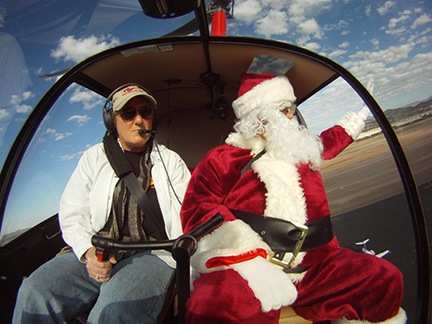
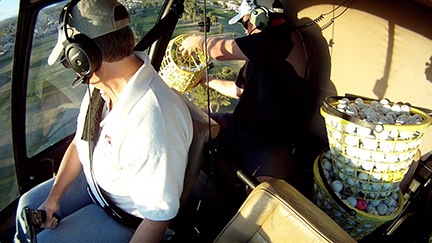
In the Santa shot, the suction cup mount is nearly center on the cockpit bubble, pointing straight back. In the golf ball drop, the suction cup mount is very close to the front passenger door.
There is another solution for cockpit use if you’re more interested in showing the pilot/passengers than the view. I have had some good success with the suction cup mount on the inside of the cockpit bubble (passenger seat only; you don’t want that thing falling down on the pilot’s side and getting caught up in the pedals) and also hanging from that silly window above the front passenger seat. Again, the camera is inverted for both of these methods. For video, to minimize vibration, you want to mount it as close to the airframe as possible. This kind of mount is not as stable as the one illustrated earlier. I use it quite a bit for still photos when I have something interesting to show, like Santa or a golf ball drop.
A few things to remember when mounting a GoPro — or any device — inside the helicopter cockpit.
- Make sure it’s secure. You don’t want objects coming loose during flight, especially if a door is off.
- Don’t mount anything where it could interfere with the pilot’s controls. That includes mounting where it could fall into the pilot’s controls.
- Remove the dual controls if anything is mounted in the front passenger side. You might also want to cover where the pedals go to make sure nothing can fall in there.
That’s about all I can tell you about this. If you have any questions or comments or you want to share a link to a photo or video you shot using this technique, please use the Comments for this post so everyone can see what you have to say or show.
Discover more from An Eclectic Mind
Subscribe to get the latest posts sent to your email.

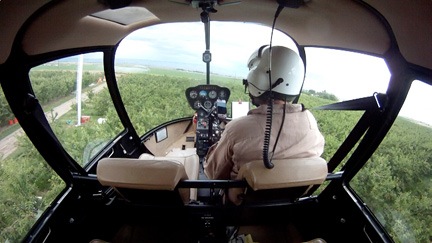
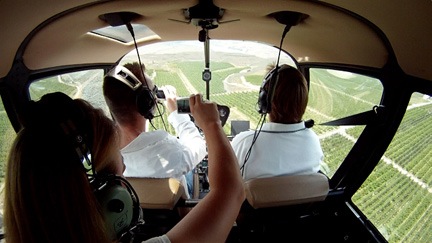

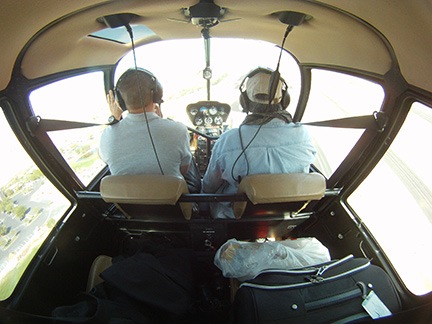
Once again, good advice about mounting GoPro cameras inside a helicopter. I’ve had a GoPro + mount fall into the area of the anti-torque pedals. Fortunately someone else was piloting and I was able to grab the camera and mount off the floor before it could interfere with the controls.
A suggestion if I may about shots in which the exterior becomes over exposed—When concerned about over exposure while the camera is shooting into the sun, you can correct for this by setting the exposure meter on the GoPro to ‘spot.’ This will insure that the exposure meter is always ‘reading the light’ from the exterior of the helicopter. That way the exterior exposure will remain consistent.
Thanks Maria for sharing your experiences. With the GoPro cameras becoming so popular, this is good counsel. Take heed ye who would use the GoPro.
Thanks for that tip about the spot exposure metering. I’ll give it a try next time I use the cockpit setup.
Have you tried mounting to the outside? I tried with the suction cup, spectra lines and lots of tape (masking and duct tape) to secure it with. (def won’t mount it to FWd Pax side since that’s tail rotor side) Vibration was terrible I mounted it to Aux tank as it was the most stable part I could find on the side. Footage is jello and unusable. You have any suggestions. I don’t fly in the US so no need to get FAA on me :) I think the suction cup is the problem here!? also tried the rear stabliser (5 min ago) but also jello and totally unusable with suction cup. (don’t worry I taped the hell out of the spectra lines and its on the furthest corner). If it does come loose the worst that would happen is hanging from the far corner of stabliser or the camera is gone (in forward flight)). Didn’t attach the line anywhere near the stinger or that side. Obviously the worst case scenario is much worse but we don’t need to talk about that.
I would not recommend using the suction cup mount on the outside of any aircraft, no matter how much tape you use. The suction cup is not reliable. Tape melts, freezes, stretches, and tears. Relying on these on the outside of an aircraft (or any other vehicle) during flight (or movement) is really risky.
The key to reducing vibration is to keep the camera body as close to the airframe as possible. On an R44, the airframe is mostly those gray metal tubes — the closer to one of those you are, the less vibration there will be.
Good luck and fly safe!